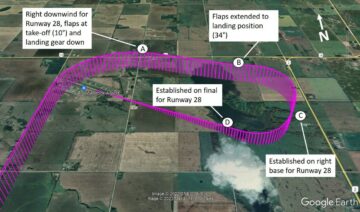
Dorval, Quebec, 21 February 2023 — Today, the Transportation Safety Board of Canada (TSB) released its investigation report (A22Q0084) into a July 2022 fatal collision with a power line cable of a privately registered, float-equipped, Bellanca 7GCBC (Citabria) aircraft in Shawinigan, Quebec.
The TSB conducted a limited-scope class 4 investigation into this occurrence to advance transportation safety through greater awareness of potential safety issues. See the Policy on Occurrence Classification for more information.
The TSB is an independent agency that investigates air, marine, pipeline, and rail transportation occurrences. Its sole aim is the advancement of transportation safety. It is not the function of the Board to assign fault or determine civil or criminal liability.
History of the flight
At approximately 1530 on 17 July 2022, the privately registered, float-equipped, single-engine Bellanca 7GCBC (Citabria) aircraft (registration C-GOQZ, serial number 74174) took off for a local visual flight rules (VFR) flight from Trois-Rivières Airport (CYRQ), Quebec, to Shawinigan, Quebec. The purpose of the flight was for the pilot, who was alone on board, to position his aircraft on the Saint-Maurice River, near downtown Shawinigan, for the summer season. Given that the aircraft was not equipped with amphibious floats, the departure from CYRQ was conducted by towing the aircraft on a trailer behind a pickup truck. Less than an hour after departure, the aircraft was seen flying over the Saint-Maurice River, from west to east, in Shawinigan. Approximately 10 minutes later, the aircraft was seen flying over the river once again, near the same location, but this time it was flying from east to west at low altitude, until it collided with the lower cable of a power line, which was at a height of about 20 m. After the impact, the aircraft fell into the river in an inverted position. The pilot was fatally injured.
Weather information
According to the aerodrome routine meteorological report (METAR) issued at 1500 for CYRQ, which is situated 10 nautical miles (NM) south-southeast of the accident site, the weather conditions were favourable for this VFR flight and were not considered to be a contributing factor in this accident.
Pilot information
The pilot held a Canadian private pilot licence – aeroplane, issued in July 2009, and a medical certificate which, according to Transport Canada (TC) records, had expired on 01 March 2020. The investigation was unable to determine whether the pilot had renewed his certificate after that date.
He had the ratings needed to fly single-engine landplanes and seaplanes. He had accumulated approximately 575 hours on the occurrence aircraft since he became the owner, in 2013.
Although the pilot was quite familiar with the Shawinigan area, this was the first time he was using this particular portion of the Saint-Maurice River to dock his aircraft.
According to information gathered during the investigation, there was no indication that the pilot’s performance was degraded by medical or physiological factors.
Aircraft information
The Bellanca 7GCBC (Citabria) is a single-engine 2-seat tandem aircraft that is commonly equipped with floats. At the time of the occurrence, the aircraft had accumulated about 2474.6 hours of air time, including approximately 1 hour for the occurrence flight. A review of the aircraft’s journey log and technical records did not reveal any outstanding defects that could have contributed to the occurrence. According to the wreckage examination, there was no indication that an aircraft system or component malfunction had contributed to this occurrence .
Accident site
The accident occurred over the Saint-Maurice River in Shawinigan, not far from the destination dock, where a Hydro-Québec power line crosses the river, 3.5 NM west of a hydro dam. While flying over the landing site, the aircraft struck the lower cable on this power line (Figure 1).

The damage to the lower cable matched the damage to the aircraft wreckage (Figure 2). Clear signs of contact with the cable were visible on the propeller blades, the left windshield post (Figure 3) and the left-wing strut (Figure 4).



Low-altitude flight
Intentionally flying at low altitude increases the risk of an accident: the pilot’s field of vision is reduced and consequently, the pilot has less time to take action to avoid obstacles and terrain. It is also recognized that flying at low altitude reduces the margin of safety in the event of engine failure, a loss of control, or any other unexpected circumstances, while increasing the risk of an impact with the ground or an obstacle. The Canadian Aviation Regulations (CARs) and other publications make specific mention of these risks., Furthermore, over the years, the TSB has investigated numerous occurrences in which low-altitude flight was identified as a contributing factor.
Under certain circumstances and for a variety of reasons, a pilot may decide to fly over a point of interest on the ground at low altitude. For instance, the pilot may wish to inspect a planned landing area and the potential obstacles near a destination dock. If the pilot’s attention is fully focused on observing this point of interest on the ground, the pilot stops watching where the aircraft is heading and may not detect obstacles along the route.
- SEO Powered Content & PR Distribution. Get Amplified Today.
- Platoblockchain. Web3 Metaverse Intelligence. Knowledge Amplified. Access Here.
- Source: https://canadianaviationnews.wordpress.com/2023/02/27/investigation-report-fatal-collision-in-shawinigan-quebec/
- 1
- 2020
- 2022
- a
- About
- accident
- According
- Accumulated
- Action
- advance
- advancement
- After
- agency
- AIR
- aircraft
- airport
- alone
- and
- approximately
- AREA
- attention
- aviation
- avoid
- awareness
- behind
- board
- cable
- Canada
- Canadian
- cars
- caused
- certain
- certificate
- circumstances
- clear
- commonly
- component
- conditions
- conducted
- Consequently
- considered
- contact
- contributed
- contributing
- control
- could
- Criminal
- Date
- destination
- Determine
- DID
- Dock
- Downtown
- during
- earth
- East
- Engine
- equipped
- Event
- factors
- Failure
- familiar
- far
- February
- field
- Figure
- Files
- First
- first time
- flight
- flying
- focused
- from
- fully
- function
- Furthermore
- given
- greater
- Ground
- Heading
- height
- Held
- HOURS
- HTML
- HTTPS
- Hydro-Québec
- identified
- image
- Impact
- in
- Including
- Increases
- increasing
- independent
- indication
- information
- instance
- interest
- investigates
- investigation
- Issued
- issues
- IT
- journey
- July
- known
- landing
- Licence
- Line
- local
- location
- loss
- Low
- make
- Margin
- Marine
- matched
- max-width
- medical
- minutes
- more
- Near
- needed
- numerous
- obstacle
- obstacles
- occurred
- Other
- outstanding
- owner
- particular
- performance
- Pickup
- pilot
- pipeline
- planned
- plato
- Plato Data Intelligence
- PlatoData
- Point
- position
- Post
- potential
- power
- private
- publications
- purpose
- Quebec
- Rail
- ratings
- reasons
- recognized
- records
- Reduced
- reduces
- registered
- Registration
- released
- renewed
- report
- reveal
- review
- Risk
- risks
- River
- Route
- rules
- Safety
- same
- Season
- serial
- Signs
- since
- site
- Source
- specific
- Stops
- summer
- system
- Take
- Tandem
- Technical
- The
- Through
- time
- to
- today
- trailer
- transport
- transportation
- truck
- TSB
- Unexpected
- variety
- visible
- vision
- watching
- Weather
- West
- whether
- which
- while
- WHO
- WordPress
- years
- zephyrnet












